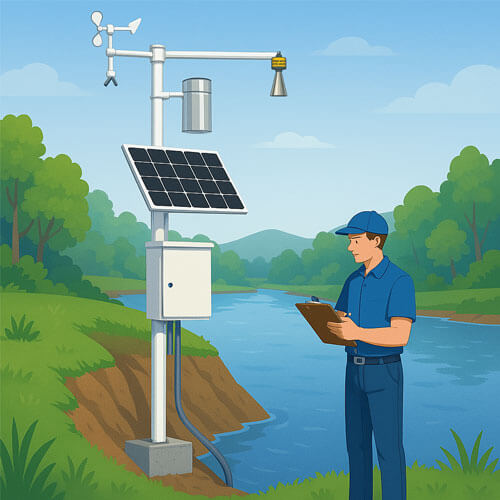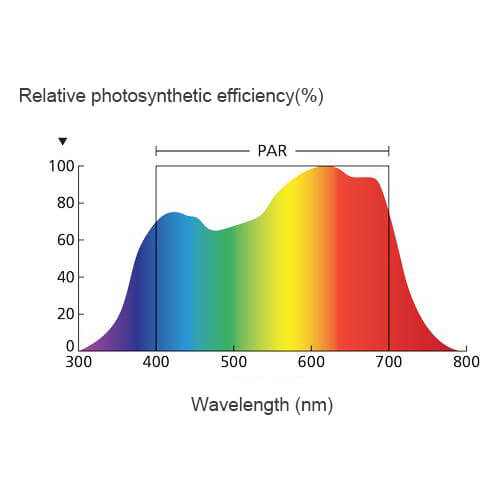What are wireless sensors?
Wireless sensors are miniature electronic devices that integrate sensing, data processing, and wireless communication functions. They are capable of autonomously detecting physical quantities in the environment, such as temperature, humidity, light, pressure, motion, etc., and transmitting the data in real-time to central nodes or cloud platforms via wireless networks. Their core components include:
- Sensor module: collects environmental data (such as temperature sensor, motion sensor, etc.).
- Processing module: The microcontroller (MCU) is responsible for data processing and algorithm execution.
- Wireless communication module: supports Wi-Fi, Bluetooth, ZigBee, LoRa and other protocols.
- Power module: usually a battery or energy harvesting device (such as solar energy).
7 types of wireless sensors
There are many types of wireless sensors, covering various fields such as environmental monitoring and industrial production. Below are the seven most commonly used wireless sensors:
Wireless temperature sensors
The core function of wireless temperature sensors is to monitor the temperature of the environment or objects in real-time and transmit the data wirelessly. In industry, they are embedded in machinery or electrical equipment to continuously monitor the temperature changes of critical components such as motors and transformers. For example, wireless sensors inside the gearbox of a wind turbine can provide early warnings of overheating risks, preventing equipment failure due to lubrication failure. In cold chain transportation, wireless temperature sensors installed on insulated boxes can record temperature fluctuations throughout the process, ensuring the safety of biological products.
Wireless vibration sensors
Wireless vibration sensors are intelligent monitoring devices used to detect the vibration status of objects or equipment. They are widely applied in fields such as industrial equipment health management, building structural safety monitoring, and transportation infrastructure maintenance. These sensors do not require wiring and use wireless communication technology to transmit data. They can remotely and continuously monitor vibration conditions, enabling the timely detection of anomalies and helping to prevent equipment damage or structural safety risks.
Wireless motion sensors
Wireless motion sensors are intelligent devices used to detect the movement status of objects or individuals. Their working principles typically rely on technologies such as infrared detection, ultrasonic detection, or microwave detection. When installed in homes, offices, or shopping malls, they can detect the movement of intruders. They are also used in smart home systems, where users can control other devices, such as lights, curtains, and air conditioning, through the activation of motion sensors, enabling automation.
Wireless pressure sensors
Wireless pressure sensors are used to measure the pressure of liquids or gases. Their working principle is typically based on the piezoresistive strain principle: when pressure is applied to the sensor’s sensitive element, the element deforms, causing a change in resistance. In water supply systems, wireless sensors can monitor pressure changes in pipelines in real-time, helping to detect leaks or blockages. In the petrochemical industry, sensors are used to monitor the pressure of storage tanks and pipelines, preventing accidents caused by abnormal pressure. In medical systems, sensors are used to monitor pressure changes within the patient’s body, such as blood pressure monitoring.
Wireless air sensors
Wireless air sensors are used for real-time monitoring of air quality, detecting parameters such as PM2.5, PM10, CO2, temperature, and humidity. These sensors include the air quality sensor that measure particulate matter concentration using the light scattering principle, and the gas sensor that measure the concentration of specific gases using electrochemical principles. Wireless air sensors are widely used in smart homes, industrial environment monitoring, indoor air quality monitoring, and other fields.
Wireless liquid sensors
Wireless liquid sensors are used to monitor parameters such as the presence, level, flow, or quality of liquids. Their working principles are typically based on capacitance, resistance, ultrasonic, or optical methods. For example, capacitive sensors determine level changes by measuring the effect of the liquid on the electric field, while ultrasonic sensors emit and receive ultrasonic signals to calculate the distance to the liquid surface, thus determining the liquid level height.
Wireless light sensors
Wireless light sensors are used to detect parameters such as light intensity, color, and position. When installed indoors, wireless sensors can automatically adjust lighting brightness to enhance living comfort. In a workshop, they can monitor the lighting conditions of production lines to ensure product quality. Outdoors, they can detect air quality, ultraviolet (UV) intensity, and provide meteorological data.
What are types of wireless sensor protocols?
RFID
RFID (Radio Frequency Identification) is a non-contact automatic identification technology that uses radio frequency signals to automatically identify targets and retrieve relevant data. An RFID system consists of a tag, a reader, and an antenna.
The working principle of RFID is relatively simple: when the tag enters a magnetic field, it receives the radio frequency signal emitted by the reader. The tag then either sends the product information stored in the chip using energy derived from the induced current (Passive Tag) or actively transmits a signal at a specific frequency (Active Tag). The reader decodes the information and sends it to a central information system for further data processing. RFID is widely used in security and anti-counterfeiting, industrial automation, vehicle tracking, and parking systems.
ZigBee
ZigBee is a new wireless communication technology that operates on a low-speed, short-range transmission protocol. Its main features include low data rates, low power consumption, low cost, and the ability to support a large number of network nodes.
ZigBee, along with Bluetooth and Wi-Fi, is part of the IEEE standard network protocols that operate in the 2.4 GHz frequency band. However, due to their different performance characteristics, each technology is suited to different applications. In ZigBee technology, a symmetric key security mechanism is used, with keys generated and managed by the network and application layers according to the specific application. These keys are responsible for storage, transmission, and updating. ZigBee technology has been widely applied in areas like smart homes in the United States.
Bluetooth
Bluetooth is a globally recognized open standard for wireless data and voice communication. It is based on low-cost, short-range wireless transmission to establish connections between fixed and mobile devices. Bluetooth features low cost, short-range communication, and strong security. Bluetooth devices must pair within a specific range to establish a connection. Once paired, the connection can have one master device and multiple slave devices.
WiFi
WiFi, short for Wireless Fidelity, is a wireless communication technology with the major advantage of high data transmission speeds, reaching up to 11 Mbps. Additionally, it offers a relatively long transmission range: in open areas, its communication distance can reach up to 305 meters, while in enclosed spaces, the range typically spans from 76 to 122 meters.
LoRaWAN
LoRaWAN (Long Range Wide Area Network) is a low-power, wide-area wireless communication protocol designed specifically for IoT applications. Its key features include long-range transmission, low power consumption, low data rate, and support for large-scale device connectivity. LoRaWAN is ideal for applications that require remote monitoring, such as agricultural monitoring, smart cities, environmental monitoring, and asset tracking.
GPRS
GPRS is a wireless packet-switched technology based on the GSM system, providing end-to-end, wide-area wireless IP connectivity. It offers advantages such as real-time, fast, and flexible data transmission. GPRS is a 2.5G communication technology that serves as a bridge between the GSM network and third-generation mobile communication systems, offering significant advantages in many areas.
NB-IoT
NB-IoT (Narrowband Internet of Things) is a type of IoT technology characterized by low cost and wide coverage. NB-IoT includes six key application scenarios: location tracking, environmental monitoring, smart parking, remote metering, agriculture, and livestock farming. These applications are typically challenging for existing mobile communication networks to support due to their specific requirements for low power consumption, long-range coverage, and large-scale deployments.
Wireless network topology types
| Types | Point-to-Point | Mesh Network | Star Topology | Tree Topology | Bus Topology |
|---|---|---|---|---|---|
| Definition | The two devices communicate directly without any intermediate nodes. | All nodes are connected to each other and data is transmitted via multi-hop paths. | All terminal devices are connected to a central node (such as a wireless router). | Hierarchical structure, the root node connects multiple child nodes, and the child nodes then expand branches. | All devices share a single transmission medium |
| Features | Simple and direct, high bandwidth, low latency | Decentralization, high redundancy, self-healing capability | Centralized control, simple management | Hierarchical management, strong scalability | Easy to implement, shared media, easy to expand |
| Applications | Communications between buildings, satellites and ground stations. | Smart home, city-level Wi-Fi coverage. | Home Wi-Fi network, small office network. | Enterprise-level wireless network, campus network. | Small local area network, sensor network. |
| Pros | High stability and high transmission efficiency. | High reliability and flexible expansion. | The deployment is simple and terminal devices do not require complex configuration. | The structure is clear and easy to expand. | Simple to implement, suitable for small networks. |
| Cons | Only supports two devices and has poor scalability. | Complex deployment and potentially high latency. | Failure of the central node will cause the entire network to be paralyzed. | Failure of the root node or upper-level node affects the lower level. | Susceptible to interference, difficult to detect and locate faults. |
Differences between wireless sensors and wired sensors
Wired sensors are among the most common types of sensors. In many cases, wired sensors are one of the most reliable systems because they directly connect the sensor to the receiving device. This means wired sensors are also the most durable systems, requiring less frequent replacements. However, wired sensors require a significant amount of space and are much more complex to maintain. As the number of sensors increases, this burden grows.
Wireless sensors, as an alternative, are favored mainly because they are easy to install and wireless sensor networks offer greater flexibility. Despite these benefits, wireless sensors still have some drawbacks. For example, they are often limited by range because the data transmission speed depends on the relative position of the sensor to the receiving device.
When comparing wireless sensors to wired sensors, what are the key differences? Of course, wireless sensors have wireless transmission capabilities, which wired sensors lack. Additionally, wireless sensors cannot directly collect data, whereas wired sensors can.
Conclusion
Renke designs and manufactures sensors for a wide range of IoT applications. Our product catalog includes temperature and humidity sensors, weather sensors, gas sensors, industrial sensors, water quality sensors, air quality sensors, and more. We provide professional solutions for smart homes, industrial automation, smart agriculture, and other fields.
Unsure which wireless sensor can meet your specific needs?
Contact Renke to share more details about your intended application. Our team will provide you with the best solutions and high-quality sensors tailored to your requirements.
FAQs
1. How does a wireless sensor work?
Wireless sensors collect on-site node monitoring data such as temperature, temperature and humidity, pressure, gas, liquid level, etc. by connecting to wired sensors, and upload the data to the smart gateway, collector or server wirelessly.
2. Can wireless sensors be used independently?
Yes, each wireless sensor is regarded as a node, has wireless communication capabilities, and also has certain signal processing and network data.
3. What are the advantages and characteristics of wireless sensors?
- High flexibility, suitable for situations where there is a need for mobility but it is inconvenient to wire
- High reliability
- High security
- Wireless sensors can significantly reduce the workload of personnel
- Low cost. Wireless sensors have obvious cost advantages over the installation, maintenance, fault diagnosis and upgrade wiring costs of wired sensors.
4. How many power supply methods are there for wireless sensors?
Battery, external power supply, solar power supply, etc., choose different power supply methods according to specific application needs. Currently, battery power supply is more commonly used.
5. What types of wireless sensors are there?
Sensors can be divided into: electrical sensors, magnetic sensors, displacement sensors, pressure sensors, vibration sensors, speed sensors, acceleration sensors, flow sensors, flow velocity sensors, temperature sensors, light sensors, ray sensors, analytical sensors, bionic sensors, gas sensors, ion sensors, etc. according to their functions.
6. What are the installation methods of wireless sensors?
The main installation methods of wireless sensors include wall-mounted and plug-in.
7. In what fields are wireless sensors mainly used?
Wireless sensors have the characteristics of low power consumption, no wiring required, low cost, simple installation and convenient maintenance. They are widely used in petrochemical, agriculture, electricity, medical, construction, environmental protection, manufacturing and other fields.











